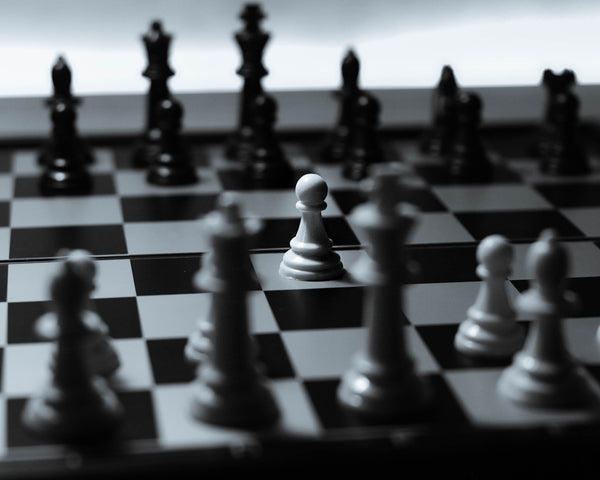
Whether you’ve been playing for a long time or want to pick it up and learn more about the game of chess. It’s good to know how to play the game, and each chess piece has specific and unique capabilities and roles. We’re here to help you understand in detail how to use each piece and what their range of motions are! Without further ado, here is each chess piece and its capabilities.
Pawns - Let's start with the most basic chess piece, but also potentially the most underrated piece with big potential. The pawn can move vertically forward one square, unless they have not moved at all since their starting position, in which case they can move two squares forward. Pawns are also the only piece on the board that ‘capture’ another piece different from how they move. Pawns capture in a diagonal line, one square ahead of them. Pawns however, cannot move backwards in any situation. Now pawns may seem as the bottom of the barrel when it comes to chess pieces, which at first might be true. But if you guide your pawn to the other side of the chess board (the back of the opponent's side) you can promote that pawn to any other chess piece, except for a king.
Pawns are often used for exactly what their name stands for… To sacrifice for other chess pieces, skilled players often strategically move their pawns in defensive positions to cover their other, more important pieces. However, a pawn can become a queen if safely traversed across the opponent's side of the board.

Knights - Moving onto arguably one of the coolest chess pieces on the board, we have the knight. Knights move in ‘ L ’ shaped motions at all times. They must be able to jump from the top of the L to the curved end in order for the move to be valid. This is seen as two squares in a horizontal or vertical direction, then move one square horizontally or vertically, depending on the spacing and layout. Remember any moves made with the knight must resemble an ‘ L ‘. The knight is also the only piece on the entire board that can jump over other pieces in its way. While other pieces cannot directly go through or over other pieces without capturing.
Knights are used most effectively as a mobile attacking and defense infiltrating piece, thanks to its ability to jump over other pieces and sometimes unpredictable move options.

Bishops - These pieces can move any number of squares, as long as it is in a diagonal direction, and no other pieces are blocking the way. The bishops cannot jump over any pieces. This piece rules over the diagonal movement on the board, each player has two to start with, one on the light squares, and one on the dark squares.
The bishops can prove very useful as they can travel from one end of the board to another in one single move, as long as all the conditions are met. These pieces can wreak havoc and be troublesome for the opponent, especially when working in tandem with other pieces.
Rooks - The best offense is a good defence has never meant more then when talking about the rook. The rook can move horizontally or vertically for any number of squares, but is unable to jump over other pieces. Rooks also must move when the king does a ‘castle’ move.
Rooks are often used as defencive pieces, their ability to move across the board horizontally and vertically create a strong presence and are often used to remove/capture invading pieces.

Queen - Arguably the most powerful and useful chess piece on the entire board. Queens can move diagonally, horizontally, vertically and backwards. This piece can move any number of squares as long as there's no other piece in front of them, as she cannot jump over other pieces.
The queen is the most powerful and versatile piece on the chess board, she can move in any direction in unlimited spaces, as long as there's nothing in her way. Each player has 1 queen, and starts on the central square that matches the piece’s color (a black queen starts on the black square in the middle of all the other pieces, a white queen on a white square).

King - Every chess player's favourite and most important piece! The king can move one square in any direction, as long as that square is not under attack (an opposing piece can put the king in check) by an enemy piece. Additionally, the king can make a special move known as ‘castling’. When you castle, you simultaneously move your king and one of your rooks.
Thereby, you move the king two squares towards your rook and then move the rook to the square over which the king crossed (make sure that you do these moves in order, otherwise it won't count as a valid move in the game of chess.
The king is the most important piece in any chess game, he is placed next to the queen and surrounded by all the other pieces. The king is the most important piece because when you checkmate the opponent's King you win the game! Thus it is crucial to keep your king safe and weaken the opponent’s.
So there you have it, how many of the pieces did you know? Did you know them all? Now you can practice against friends and family while improving your cognitive skills and developing new problem solving solutions! Get your own unique chess board, and challenge yourself and your friends or even strangers! Shop now! Click Here


